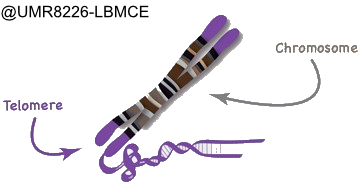“Molecular and Cellular Responses to the Shortest Telomere in Saccharomyces cerevisiae”
directed by Dr Teresa Teixeira.
The defense will take place on Friday, October 11, 2024, at 2:00 PM, in the Edmond de Rothschild Library at the Institut de Biologie Physico-Chimique (IBPC), located at 13 rue Pierre et Marie Curie, 75005 Paris.
Abstract:
In the absence of telomerase, telomere shortening triggers replicative senescence, a potent tumor suppressor mechanism. Yet, this phenomenon is associated with genomic instability typical of cancer. Cancer genomes often exhibit extensive chromosome rearrangements that facilitates oncogenic progression and telomere dysfunction has been proven to contribute to these genetic disorders. When telomeres fall below a critical length, they activate the DNA damage checkpoint and cells enter senescence. Due to the shortening process, telomere lose their protective function increasing the risk of recruiting DNA damage repair activities that would degrade, fuse, or recombine dysfunctional telomeres, initiating
genome instability. However, the structure(s) of short vs dysfunctional telomeres, which either trigger permanent replicative senescence or potentially promote genome instability, respectively, remains a longstanding question. The aim of my PhD research has been to define the telomeric structure(s) involved in the transition between a critically short and a
dysfunctional telomere and to define its contribution to genome stability at the time of replicative senescence in Saccharomyces cerevisiae. Telomere research is inherently challenging due to the variability caused by differences
between telomeres and phenotypic variations related to replicative senescence. In this project, we used a combination of tools to address the heterogeneity and the rarity of genome instability related to telomeres in the context of physiological telomere shortening, recapitulating the first steps of oncogenesis. We developed a system, called FinalCut, to track
the shortest telomere in Saccharomyces cerevisiae telomerase negative cells. Using single-telomere and single-cell analysis combined with mathematical modelling, we show that this telomere switches into dysfunction when reaching a threshold length. This is required and sufficient to determine the onset of replicative senescence in a majority of cells. We also found
that the majority of genomic instability in the absence of telomerase stems from this same shortest telomere in the cell. Together, our results support a model where the switch of the shortest telomere into dysfunction and subsequent degradation in telomerase negative cells, serves as a mechanistic link between replicative senescence onset, genomic instability and the advent of post-senescence survivors, explaining the multiple roles of replicative senescence in
oncogenesis.
Keywords
Telomeres, telomerase, replicative senescence, genomic instability, gross chromosomal rearrangements, DNA repair, Alternative Lengthening of Telomeres (ALT), CRISPR/Cas9, microfluidics, mathematical modelling
The members of my jury is composed of :
Eros Lazzerini-Denchi, Ph.D. – Reviewer, National Institutes of Health (NIH), Bethesda, MD, USA
Brian Luke, Ph.D. – Reviewer, Institute of Molecular Biology (IMB), Mainz, Germany
Laure Teysset, Ph.D. – Examiner, Institut de Biologie Paris Seine (IBPS), CNRS/ Sorbonne Université, Paris, France
Bertrand Llorente, Ph.D. – Examiner, Institut Paoli-Calmettes, CNRS/INSERM/Aix Marseille Université, CRCM, Marseille, France
Aurèle Piazza, Ph.D. – Examiner, Laboratory of Biology and Modeling of the Cell, ENS Lyon, France

